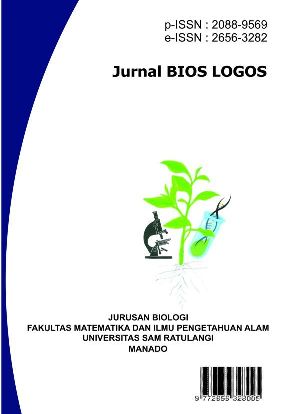Isolation and Characterization of Potential Lignocellulosic Degrading Bacteria From chicken Manure Compost
DOI:
https://doi.org/10.35799/jbl.v13i2.42791Keywords:
Shigella flexneri, lignocellulosic bacteria, chicken manure, lignocelllulosic enzymeAbstract
Lignocellulose is the main component that can be found in plants. Lignocellulose consists of three components, namely hemicellulose, lignin, and cellulose. The maximum utilization of lignocellulose cannot be carried out without being degraded, however there are difficulties in carrying out the degradation. The difficulty faced in the degradation process is the presence of lignin components that provide strength and stiffness to the plant, which make it is quite resistant to the degradation process. Lignocellulose degradation requires delignification. The delignification process can be facilitated by enzymes produced by a number of microorganisms, including bacteria can produce lignocellulosic enzymes. This study aims to isolate and characterize lignocellulose-degrading bacteria in chicken manure, and to assess the ability of bacteria to degrade lignocellulose. The results obtained from this research showed that an isolate which has high similarity with Shigella flexneri bacteria which was found in chicken manure and exhibits a potential to degrade lignocellulose.
References
Aini F (2018) Isolasi dan Identifikasi Shigella sp. Penyebab Diare Pada Balita. Bio-site 4(1): 1-40.
Boleng DT (2015) Bakteriologi: Konsep-Konsep Dasar. Universitas Muhammadiyah Malang Press, Malang.
Brodeur G, Yau E, Badal K, Collier J, Ramachandran KB, and Ramakrishnan S (2011) Chemical and Physicochemical Pretreatment of Lignocellulosic Biomass: A Review. Enzyme Research 11: 1-17.
Disale SN, and Dixit PP (2020) Isolation, Identification, and Functional Diversity of Lignocellulose Degrading Bacteria. Indian Journal of Applied Research 10(2): 15-17.
Eisenhuber K, Krennhuber K, Steinmüller V, and Jäger A (2013) Comparison of Different Pre-Treatment Methods for Separating Hemicellulose from Straw during Lignocellulose Bioethanol Production. Energy Procedia 40(13): 172-181.
Gonzalo G, Colpa DI, Habib MHM, and Fraaije MW (2016) Bacterial Enzymes Involved in Lignin Degradation. J. Biotechnology 236: 110-119.
Handoko YA, Kristiawan YA, and Agus YH (2020) Isolasi dan Karakterisasi Biokimia Bakteri Pembusuk Cabai Rawit. Teknologi Pangan: Media Informasi dan Komunikasi Ilmiah Teknologi Pertanian 11(1): 34-41.
Imsya A, Laconi EB, Wiryawan KG, and Widyastuti Y (2014) Biodegradasi Lignoselulosa dengan Phanerochaete chrysosporium terhadap Perubahan Nilai Gizi Pelepah Sawit. Jurnal Peternakan Sriwijaya 3(2): 12-19.
Kasi PD, Suhaeini, and Sasa (2020) Karakterisasi Morfologis Isolat Bakteri Termofilik dari Sumber Air Panas Pincara. J. Pend. Sains Biol 3(2): 51-56.
Leboffe MJ, and Pierce B (2010) Microbiology Laboratory Theory & Application. Morton Publishing Company, Colorado.
Ma L, Zhao Y, Meng L, Wang X, Yi Y, Shan Y, Liu B, Zhou Y, and Lü X (2020) Isolation of Thermostable Lignocellulosic Bacteria From Chicken Manure Compost and a M42 Family Endocellulase Cloning From Geobacillus thermodenitrificans Y7. Frontiers in Microbiology 11: 1-15.
Menon V, and Rao M (2012) Trends in Bioconversion of Lignocellulose: Biofuels, Platform Chemicals & Biorefinery Concept. Progress in Energy and Combustion Science 38: 522-550.
Moningkey GS, Andaki JA, Dien CR, Jusuf N, Rarung LK, and Moningkey RD (2021) Evaluasi Pengendalian Eceng Gondok (Eichornia crassipes) Di Danau Tondano Kabupaten Minahasa Dalam Masa Pandemi Covid-19. Akulturasi 9(1): 65-77.
Murtiyaningsih H, and Hazmi M (2017) Isolasi dan Uji Aktivitas Enzim Selulase Pada Bakteri Selulotik Asal Tanah Sampah. Agritop 15(2): 293-308.
Napitapulu HG, Rumengan IFM, Wullur S, Ginting EL, Rimper JRTSL, and Toloh BH (2019) Bacillus sp. sebagai Agensia Pengurai Dalam Pemeliharaan Brachionus rotundiformis yang Menggunakan Ikan Mnetah Sebagai Sumber Nutrisi. Journal Ilmiah Platax 7(1): 158-169.
Nur, R.A., N. Nazir, and G. Taib. 2020. Karakteristik Bioplastik dari Pati Biji Durian dan Pati Singkong yang Menggunakan Bahan Pengisi MCC (Microcrystalline cellulose) dari Kulit Kakao. Gema Agro. 25(1): 1-10.
Nurliana, Tanjung A, Sabri M, Masyitah D, Jalaluddin M, and Rastina (2019) Additional Effect of Soybean Waste Probiotic and Palm Kernel Fermented with Aspergillus niger (Akbis Prob) on The Growth of Broiler Bone. Jurnal Medika Veterinaria 13(1): 88-95.
Nurika I, Nisa FN, Azizah N, and Suhartini S (2021) Optimasi Kondisi Ektraksi Vanillin Hasil Degradasi Lignoselulosa Bagas Tebu Menggunakan Response Surface Method (RSM). Jurnal Bioteknologi dan Biosains Indonesia 8(1): 89-104.
Purnawan A, Thontowi A, Kholida LN, and Perwitasari U (2021) Hidrolisis Biomasa Lignoselulosa Untuk Xilitol. Jurnal Ilmu Lingkungan 19(3): 485-496.
Putri ALO, and Kusdiyantini E (2018) Isolasi dan Identifikasi Bakteri Asam Laktat Dari Pangan Fermentasi Berbasis Ikan (Inasua) Yang Diperjualbelikan Di Maluku-Indonesia. Jurnal Biologi Tropika 2(1): 6-12.
Rahayu F, Murianingrum M, and Nurindah (2019) Pemanfaatan Lignin dari Biomassa Rami, Kenaf, dan Agave Untuk Sumber Bioenergi. Buletin Tanaman Tembakau, Serat, dan Minyak Industri 11(2): 73-85.
Stackerbrandt E, and Goebel BM (1994) Taxonomic Note: A Place for DNA-DNA Reassociation and 16S rRNA Sequence Analysis in the Present Species Definition in Bacteriology. International Journal of Systematic and Evolutionary Microbiology 44: 846-849.
Ummamie L, Rastina, Erina, Ferasyi TR, Darniati, dan Al Azhar (2017) Isolasi dan Identifikasi Eschericia coli dan Staphylococcus aureus Pada Keumamah di Pasar Tradisional Lambaro, Aceh Besar. JIMVET 1(3): 574-583.
Wahyuningsih N, and Zulaika E (2018) Perbandingan Pertumbuhan Bakteri Selulolitik Pada Media Nutrient Broth dan Carboxy Methyl Cellulose. J. Sains dan Seni ITS 7(2): 36-38.
Wang A, Gao L, Ren N, Xu J, Liu C, Cao G, Yu H, Liu W, Hemme CL, He Z, and Zhou J (2011) Isolation and Characterization of Shigella flexneri G3, Capable of Effective Cellulosic Saccharification under Mesophilic Conditions. Applied and Environmental Microbiology 77(2): 517-523.
Zulfikar A, Putri NPNSK, and Tajalla GUN (2020) Studi Pengaruh Waktu Alkalisasi pada Ekstraksi Selulosa Berbasis Serat Eceng Gondok (Eichhornia crassipes). SPECTA Journal of Technology 4(2): 1-12.
Zuo G, Xu Z, and Hao B. Shigella Strains are Not Clones of Escherichia coli but Sister Species in the Genus Escherichia. Genomics Proteomics Bioinformatics 11: 61-65.
Downloads
Published
How to Cite
Issue
Section
License
Copyright (c) 2023 Zhafira Tiza Maesharoh Soleman

This work is licensed under a Creative Commons Attribution-ShareAlike 4.0 International License.










